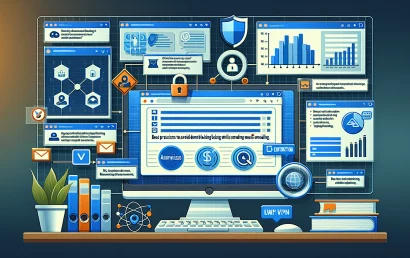Mistakes When Warming Up a Domain

When it comes to email marketing, one of the most critical steps is the process of warming up a domain. This practice involves gradually increasing the volume of emails sent from a new or inactive domain to build a positive reputation with email service providers (ESPs). However, many marketers make significant mistakes during this process that can jeopardize their email deliverability and overall campaign success.
Understanding the common mistakes in domain warming is essential for anyone looking to launch effective email campaigns. In this article, we will explore these pitfalls and provide insights on how to avoid them, ensuring that your emails reach your audience's inbox rather than getting lost in the spam folder.
Common Mistakes in Domain Warming
Neglecting a Gradual Increase in Email Volume
One of the most common mistakes marketers make is sending too many emails too quickly. When you start warming up your domain, it’s crucial to gradually increase the volume of emails sent over time. Abruptly sending a large number of emails can raise red flags with ESPs, resulting in your emails being marked as spam.
“A slow and steady approach is key to establishing trust with email providers.”
Ignoring Engagement Metrics
Another frequent error is overlooking engagement metrics. Sending emails to unengaged or inactive subscribers can negatively impact your sender reputation. It’s essential to focus on engaging your audience by targeting recipients who are likely to open and interact with your emails. This not only helps in warming up your domain but also builds a healthier email list in the long run.
Failing to Authenticate Your Domain
Authentication is a critical aspect of domain warming that many overlook. Without proper authentication (such as SPF, DKIM, and DMARC), your emails are more likely to be rejected or sent to spam folders. Ensure that your domain is properly set up with these authentication protocols to improve deliverability and build trust with ESPs.
Not Monitoring Feedback Loops
Feedback loops are essential for understanding how recipients interact with your emails. Many marketers fail to monitor these loops, which can lead to a lack of insight into potential issues. By ignoring feedback, you miss valuable information that can help you adjust your strategy and improve your domain's reputation.
Skipping the Test Phase
Finally, one of the biggest mistakes is not conducting tests before launching a full campaign. Testing your emails with a smaller audience allows you to gather data on deliverability and engagement rates. This information is invaluable in fine-tuning your approach and ensuring a successful warming process.
Main advantages and disadvantages
Advantages of Domain Warming
Warming up a domain offers several key benefits that can significantly enhance your email marketing efforts:
- Improved Deliverability: Gradually increasing your email volume helps establish a positive sender reputation, which in turn improves the chances of your emails reaching the inbox rather than the spam folder.
- Higher Engagement Rates: By focusing on engaged recipients during the warming process, you can boost open and click-through rates, leading to more successful campaigns.
- Better Sender Reputation: A well-executed warming strategy builds trust with email service providers, which is crucial for long-term email marketing success.
- Increased Customer Trust: Consistent and relevant communication fosters trust among your audience, making them more likely to engage with your emails.
Disadvantages of Domain Warming
Despite its benefits, there are also some drawbacks to consider when warming up a domain:
- Time-Consuming Process: Warming up a domain requires patience and a strategic approach, which can be time-consuming, especially for businesses looking to launch campaigns quickly.
- Risk of Mistakes: As discussed earlier, there are several common mistakes that can occur during the warming process, potentially leading to negative impacts on deliverability if not carefully managed.
- Initial Low Engagement: In the early stages of warming, you may experience lower engagement rates as you’re still building your audience and reputation.
- Resource Intensive: The process may require dedicated resources for monitoring metrics, adjusting strategies, and ensuring proper authentication, which can be a burden for smaller teams.
Thematic table
| Error | Description | Consequences | Prevention |
|---|---|---|---|
| Sending Too Many Emails Too Quickly | Launching a high volume of emails immediately after creating or reactivating a domain. | Increased likelihood of emails being marked as spam, damaging sender reputation. | Gradually increase email volume over several weeks. |
| Ignoring Engagement Metrics | Failing to track how recipients interact with emails. | Sending to unengaged users can hurt deliverability and sender reputation. | Focus on sending to engaged recipients and monitor open/click rates. |
| Failing to Authenticate Your Domain | Not setting up authentication protocols like SPF, DKIM, and DMARC. | Higher chances of emails being rejected or sent to spam folders. | Ensure proper domain authentication is in place before sending emails. |
| Not Monitoring Feedback Loops | Neglecting to check feedback from ESPs regarding email performance. | Missed opportunities to adjust strategy and improve engagement. | Regularly monitor feedback loops to gauge recipient reactions. |
| Skipping the Test Phase | Not conducting tests with a smaller audience prior to a full launch. | Potential issues with deliverability and engagement may go unnoticed. | Run A/B tests to gather data and refine email strategies before full deployment. |
| Not Segmenting Your Audience | Sending the same email to all subscribers without segmentation. | Lower engagement rates due to irrelevant content for certain audiences. | Segment your audience based on interests and behaviors for targeted messaging. |
| Disregarding Unsubscribe Rates | Ignoring the number of unsubscribes during the warming process. | High unsubscribe rates can indicate poor content relevance and hurt reputation. | Pay attention to unsubscribe rates and adjust content accordingly. |
| Using a Non-Relevant Sending Domain | Using a domain that doesn’t relate to your brand or business. | Confuses recipients and can lead to lower trust and engagement. | Use a domain that clearly represents your brand and its purpose. |
Let's summarize the category:
Warming up a domain is a crucial step in establishing a successful email marketing strategy. However, the process is fraught with potential pitfalls that can significantly impact your deliverability and sender reputation. By understanding the common errors in domain warming, marketers can take proactive measures to avoid these mistakes and enhance their email campaigns.
One of the most significant errors is sending too many emails too quickly, which can raise red flags with email service providers. A gradual increase in email volume is essential to build trust and maintain a positive sender reputation. Additionally, ignoring engagement metrics can lead to sending emails to unengaged recipients, further damaging your reputation and deliverability.
“Monitoring engagement and adjusting your strategy accordingly is vital for a successful warming process.”
Authentication plays a critical role in domain warming as well. Failing to set up proper authentication protocols like SPF, DKIM, and DMARC can result in emails being rejected or sent to spam. Moreover, not monitoring feedback loops means missing out on valuable insights that could help refine your approach and improve engagement rates.
Testing your emails with a smaller audience before a full launch is another essential step that should not be overlooked. Skipping this phase can lead to undetected issues that could harm your campaign. Additionally, not segmenting your audience can result in lower engagement rates, as sending irrelevant content to certain groups may lead to higher unsubscribe rates.
Ultimately, understanding and addressing these common mistakes can pave the way for a more effective domain warming process. By implementing best practices and continuously monitoring your email performance, you can significantly enhance your chances of success in email marketing.





